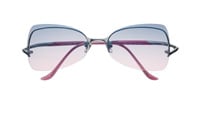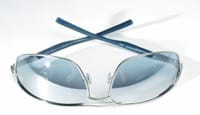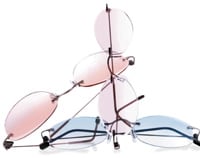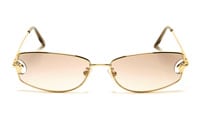Night
Moves
How fashion tinted eyewear, also known as
clubwear, is seeing the light of day
By Marcy Bruch
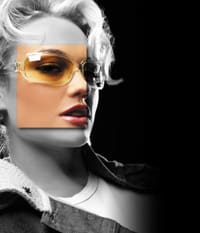
"I do about five prescriptions with lens tints a week, whereas I used to do about five a month," says Jason Engelman, owner of X-Ray Vision, in Minneapolis, Minn.
Anthony Fulco, director of sales and marketing for 21st Century Optics, a lab in Long Island City, N.Y., concurs. "We process about 300 three-piece rimless mounts per day, and of that total, about 25 percent of those jobs have tints or some kind of gradient color or flash mirror finish," he says.
The demand for gradient lens treatments has become so great at 21st Century Optics that the lab recently bought a fourth machine in order to better accommodate all the orders.
Going beyond night clubbing. Shown: Oliver Peoples' Impala with OPX photochromic lenses
Yet, there would be no reason to invest in such a machine if dispensers weren't out there today presenting all the possibilities of fashion lenses.
|
|
|
|
From top to bottom: Transitions Splitz photochromics; Kata's KE222 Philo; and REM Eyewear's Rap Id all help wearers create a hip look with plenty of practical applications to boot |
|
In New York City's hip meatpacking district, Oleg Rabinovich, co-owner of Artsee Eyewear, says three-piece rimless mounts with just a hint of color and flash mirror can be worn anytime of day, but are especially appealing to people who want something distinctive to wear during a night on the town.
Still, Rabinovich is reluctant to call this eyewear look clubwear, since it is now worn day or night among people of all ages, and has moved beyond what is was some four years ago.
"Many of my customers wear lens tints in their primary pair of glasses--it's something they wear all the time, not just at night," he says.
SHOWING OFF TINTS
Even though the increase in lens tint sales has partly been driven by celebrity exposure, not having a good selection of lens samples on hand to illustrate what's available is cause for missed sales.
Since a current best-selling fashion lens look is gradient flash mirror, Rabinovich has some 30 lens samples with gradient flash mirror coatings in a rainbow of color variations.
By holding on to demo lenses and making notes of best-selling colorations and finishes in a binder filled with samples, Engelman has built his own extensive lens library. "I keep a written record of the successful lens tints and finishes we've done in the past; that way I'm not constantly reinventing the wheel."
In addition, everyone on Engelman's staff has eyewear with tinted lenses so, on any given day, someone working at the dispensary will be wearing a pair, which also helps promote the look.
MANAGING EXPECTATIONS
Selecting fashion lens treatments is a creative process of building customized eyewear, and Engelman is quick to point out that it's important to warn customers ahead of time that the blue gradient flash lens they see in a demo lens may not look exactly the same in the finished product.
"You have to manage their expectations from the get-go. Otherwise, your redos could get out of control," he says.
|
|
|
|
Gradient pastel tints enliven a three-piece mount, Airlock from Marchon |
About 50 three-piece rimless mounts are displayed on the boards of Vision Eyeworks, in Little Neck, N.Y., says owner Arthur Singer, and each has a different lens tint color and gradient or flash mirror coating combination. "If you want to grow this area of your business, you have to invest in frame samples that will showcase all the lens treatments properly. It's a lot easier to sell someone on a gradient tint when they can actually try a tinted pair of glasses on," he says.
To make selling fashion tints a no-brainer, Fulco notes that his lab sells a fashion lens kit to dispensers, with 10 different tints and gradient finishes. "We sell it for $50, but it also includes a coupon that offers $25 worth of free lab services, so it's well worth it."
PHOTOCHROMICS RISING
Since eyewear with tints and gradient lens finishes are already a hybrid between ophthalmic and sunwear anyway, some dispensers have explored using fashion tints on photochromics with great success.
For example, Rudy Manheim, manager of the Oliver Peoples dispensary on Sunset Boulevard in West Hollywood, Calif., reports that they already have a celebrity following, including Brad Pitt and Adrian Brody, who wear their frames with photochromic lenses.
Offering gradient tinted frames that also happen to be photochromic is a natural evolution to this growing trend.
"What was purely fashion has now become functional as well," Manheim says. "Because now consumers are not only getting the fashion look for indoors and at night, but also the eyewear acts like a chameleon, transforming into sunwear with UV protection in daylight. Bottom line? They're getting that much more for their money."
|
|
|
|
Above: Wink's Enigma 471g in ember combines traditional tortoise with a modern shape and up-to-the-minute lenses |
|
MATERIAL WORLDS
Another way the fashion tint trend has evolved over the past year is in the type of frame to which it is applied. Even though all those interviewed say tints and gradient are utilized mostly in three-piece rimless mounts, shields with metal outlines have become an up-and-coming look as well. But perhaps the newest frame treatment of all is combining gradient tints with clear plastic frames that have a light wash of color in the same hue as the lens tints.
"There's no question that a three-piece rimless mount is going to make the lens treatment the fashion focal point," says Rabinovich. "But if you have a metal frame with colored stones along the temples, you can create a stunning eyewear piece by matching the tint to the stones and then adding a subtle flash mirror gradient finish for a dramatic evening accessory."
TINT CHART TOPPERS
In terms of the most popular lens tint colors, blues top the list followed by greens, then soft lavenders and pinks. But even more daring colors like orange with gold flash mirror and black cherry red tints have sold well in the Midwest, Engelman says.
At Oliver Peoples, Manheim reports his fashion flash mirror photochromics sell best in this order: chrome sapphire, chrome gold, chrome graphite, chrome amethyst, and chrome amber.
|
|
|
|
High-end chic shows that tints and gradients go beyond three-piece mounts. Shown below: Versace N33 by Luxottica |
Despite the fact that selling fashion tints can be a fun, creative process, Engelman says most important of all, it has to look right on the customer. "The older a person is, the warmer I make sure the color is, because it's just a given that we all get more ashen with age," he says.
To offset that, Engelman also likes to add a dash of rosy color at the outside lower corner of each lens to give the wearer a blush at the cheeks. Precut the lens, otherwise the color in the corners will be cut out during edging.
Engelman says that even in the conservative Midwest, the fashion-forward look of lens tints and gradients is alive and kicking.
And in New York City, Rabinovich says it's a look that's here to stay. "As long as we keep evolving lens tints with fresh color combinations and frame applications, fashion tints give consumers a strong reason to buy a second pair."
|
GOING FOR THE GOLD WITH TINTS |
Here are some ways to build business with fashion lens tints and gradients: Build a sample library. Collect discarded demo lenses, get an extra lens sample from the lab of a particularly hot-selling lens tint color. If your lab offers it, get a fashion lens sample kit, or make one yourself. Be a model. You and your staff can model eyewear with lens tints or gradient finishes. What better way to promote the product? Show the options. Try to invest in at least 10 frames that feature lens tints and gradient finishes and display them on boards. It's a lot easier to sell the products when your customers can try them on. Keep it real. Explain to the customer up front that a particular tint, gradient, or finish may not come out exactly the way it does in a demo lens. This cuts down considerably on redos. Accentuate exclusivity. Point out to your customers that when they add tints and gradients to their frames, they are customizing their eyewear so that it's one-of-a kind and better expresses their own unique personalities. |





